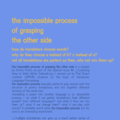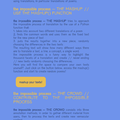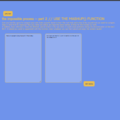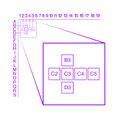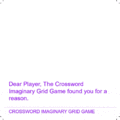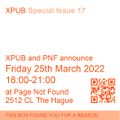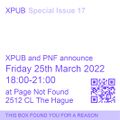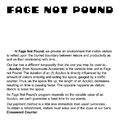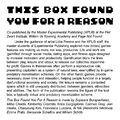User:FLEM/Final presentation: Difference between revisions
| Line 103: | Line 103: | ||
File:Crossword bar counter.jpg | File:Crossword bar counter.jpg | ||
File:Crossword bar counter launchday by Carmen Gray (4).jpg | File:Crossword bar counter launchday by Carmen Gray (4).jpg | ||
File:Invitation image RGB-04.jpg | File:Invitation image RGB-04.jpg | ||
File:Invitation image RGB-05.jpg | File:Invitation image RGB-05.jpg | ||
Revision as of 09:59, 8 June 2023
Special issue 16
My main project during the special issue 16 was the impossible process project.
Wiki research & documentation: poems translations.
Website: https://hub.xpub.nl/soupboat/theimpossibleprocess/
the impossible process of grasping the other side
the impossible process of grasping the other side is a project by Emma Prato, as part of the Special Issue 16 //Learning How to Walk While Catwalking// carried out by Piet Zwart Institute (XPUB) students on the topic of Vernacular Language Processing.
the impossible process basically wants to play around with the structure of poetry translations and mix together different versions of the same text.
translating a poem into another language is an impossible process - so what if we gather translations from different people? from different languages? and what if then we mix them up? what if we change them? what if we play with words? it probably won't solve the impossible process but for sure is an interesting experiment.
//multiple translations can give us a much better sense of the poem than a single translation can, so that even if we can’t read the poem in the original language, we can come closer to that experience° // the impossible process is made of two sections: one (THE CROWD) is to gather //vernacular// information and the other (THE MASHUP) is to process texts, which can be both taken from the vernacular content or from already existing translations. The poetry archive (work in progress) will showcase the results.
Connection with second year project
In the SI16, I analysed patterns and disrupted common structures to create new versions of texts. I created a prototype of linguistic patterns and the impossible project website, a tool for vernacular translations. Plus, I used the annotation system created for Special Issue 16 to gather translations from users. The final publication for the public to interact and understand the Python function I created has been the "letter bag", an activity that would reproduce what happens in the function and ask the user to do it by hand. In recalls what I am making in the Second Year project with the following question: what happens when you mirror digital interactions into a physical movement? In both cases, I reckon, it is a very interesting tool to make people who know nothing about coding, what is happening.
I started to understand how python scripts work and started making some website to try out things.
Contribution/groups
- I was part of ADMIN TEAM: creating the meetings, schedules, keeping track of the work.
- I was part of LAUNCH TEAM: event coordination, organisation and user experience for the launch day.
- I was part of FRONT-END TEAM: support during the creation of front-end of the website, advices and considerations.
- Content group: research on python function, set up, layout and flask for website of “the impossible process”; prints and booklet for the same project. In addition, general research for the “vernacular maps” group.
Side things
My notes documentation: User:FLEM/1.1
- collabweek3
- Station Skill html
- text waving
- transcription
- smart textile station skill
- wood station skill
- jacques prévert poems
Gallery
Special issue 17
The crossword experience:
The game is a reference to the crosswords as well as an overview of the productive play glossary, that will be found inside the loot box and represents the research part of our project.
The post-its/squared pieces of paper definitions act as a go-between the content and the players, and obviously share the values and reasons why post-its have been chosen as the mean for this project.
The idea emerged to reflect on some of our main topics (slow-thinking, delayed rewarding, gamification processes, competition, individuality, productive environment) in a gamified way.
The player will:
1. Complete a puzzle to create a word, therefore to play a game to obtain a drink, instead of having a need and satisfying it immediately. It is a critic of loot boxes philosophy and serves to slow the pace down because the players can't get the drink immediately (delayed-reward and slow-thinking).
2. By the end of the event, the public will have produced a collective work, a big crossword made by everyone in the room. It's a way to create interaction and criticise the videogames world that produces a lot of individuality and competition. Instead, this method invites the player to embrace collectivity and inclusivity.
Connection with second year project
Again, I always tried to involve a public, to explain more than what seems like needed, had in mind the idea that our public should understand and it has been underlined my intent of translating one form of research into an activity/event. One of the results of this has been the crosswords game, both for the launch day and for the publication. I like the idea that an audience can interact with what is shown to them: everyone has different learning methodologies, and it’s our job to put everyone in a situation where they can get the best out of the experience.
Contribution/groups
I did research and polished the glossary of productive play to transform it into a usable and understandable game for the public. A way to access our theoretical research through the use of gamification. The result was both presented inside the box as “The Crossword Imaginary Grid Game” and during the launch as “the Fage Not Pound Bar Counter”.
I was part of LAUNCH group: Price of the box, Texts for the launch, both documentation and presentation of the work, Prints and plotting, name tags, Plexiglas letter game for the launch.
Side things
My notes documentation: User:FLEM/1.2
- a box in a box in a box - 16_02_22 (with G&Carmen)
- Re-writing Station Skill
- Station Skill Java
- calligraphy and typography station skills
- the social side of games
- playing cards
- Glossary_of_productive_play
Gallery
Special issue 18
The SI18 structure gave more space for our personal interests, actions and reactions.
I enjoyed creating small weekly prototypes, and the possibility to try new things proposed by other people: the moment when I received the proposals and had to discover what it could be about. Then, seeing how my brain starts to work and looks for inventive solutions to learn and to try out different methods or tools.
I am happy how I managed, as a caretaker, to go deeper into my personal interests, to see how contributors reacted to the proposals (7&5) and the possibility that my ideas will change after other people experimented with them or created their own way out of it.
I am pleased to see how we could influence each other and evolve in very different ways with every method we've been using and the person we were working with. It all gave me the feeling of collective work.
Contribution/groups
Side things
My notes documentation: User:FLEM/1.3
Gallery
Development of reading/writing practice across the 2 years
Development of prototyping practice across the 2 years
My thesis
Final work and research in the second year
Plans for publication and grad show
Second Year
final work: starting from the question on how can I edit and present all of this material I gathered in the last year. I wanted to share all the little discoveries I made and what I learnt with others. The choice of the cards come together with the consciousness of how hard it is for reader to follow such a long research and using my knowledge of notebooks structures and explorations to find a fitting solution. The notebook I created and experimented on myself in November 2022 (the notebook kit), provides a special feature "It has been helpful to re-organise thoughts in very small sheets of paper. This obliged me to describe a concept in a little amount of words". By dividing the concepts and information in small pieces and by transforming the medium into an interactive activity, that allows personalisation and modularity, i invite users of this publication-game to explore the concepts at their own pace. In addition, the concept of modularity participated widely also thanks to the concept of index cards: "Secondo Lancellotti (1583–1643) created an index system in which he would insert “associative cross-references and pointers whenever and wherever possible, enabling the reader to surf through” all these annotations, “replacing reading with a type of early modern hypertext” (Cevolini, 2020).
Write in the presentation that in the notebook book there are also information and discussions on how to write where to write and questions on how it makes a difference also the notetaking practice when approaching different interfaces
Side things
- worked for V2, Worm, Mama and art and music festival (Conflux, Rewire Festival) as a host since January 2022
- worked as a archipelago member and designed and risoprinted 4 newspaper The Piet, as well as organised a series of events and workshops.


